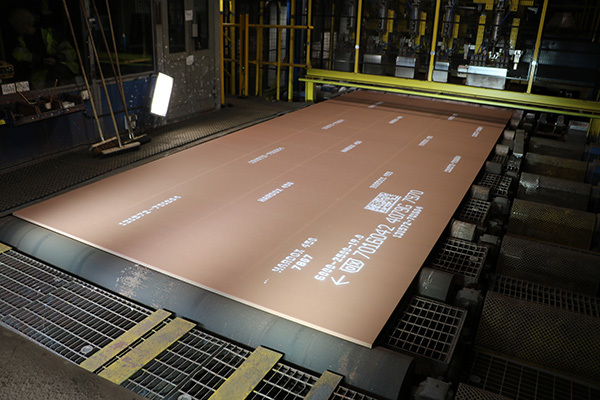Hardox® and Strenx® shop primers
SSAB can provide the Hardox® and Strenx® grades with a shop primer that provides an effective corrosion protection of plates and cut lo length sheets during storage, transportation and fabrication. The corrosion protection period is set to 6 month.
Shop primed plates in the Hardox® and Strenx® grades are coated with an inorganic low zinc silicate primer. The thickness of the primer is approximately 10-15 µm. Plates that SSAB keeps in stock are always painted with the primer.
Hardox® wear plate with red-brown shop primer.
If requested, the primer is easily removed from the parts of the plate that will be subjected to cutting and/or welding by for example a brush or a grinding tool.
Suitable welding performances
Welding can be performed with or without leaving the primer in the joint. When the primer is left on it is possible to attain advantageous results of the general properties in the joint. It is also feasible to perform welding with the same parameters as for welding a joint without a primer. However, the outcome may be further improved if the primer is removed from the joint and the adjacent surroundings prior to welding.
If the primer is left on in the joint, MAG-welding with basic types of flux cored wires is a good option since it supports a lowered level of porosity. However, beneficially low porosity levels in the weld metal can be attained in general for all other types of welding methods welded with the recommended consumables.
Principal advantages with removing the primer prior to welding
The level of porosity in the weld metal can further be lowered. For stringent requirements regarding low porosity levels, SSAB proposes that the primer is removed prior to welding. Evaluation of fillet welds that are welded in the horizontal position show that the porosity level is typically up to some percentage of the total volume of the weld metal.
Out of position welding, which means welding in other positions than the horizontal, is also enhanced by removing the primer in the joint. In these situations, there may be a tendency for insufficient bonding of the molten weld metal to the joint if the primer is not removed. This matter can cause lack of root fusion and lack of fusion in the joint.
The information in this report is only applicable to SSAB’s products and should not be applied to any other products than original SSAB products.
This report provides general results and recommendations for SSAB steel products. This report is subject to SSAB’s Terms of Use. It shall be the user's responsibility to verify that the information contained herein is correct and is suitable to be used for the particular purpose and application of the user. The report is intended to be used by professional users only who possess adequate expertise, qualification and knowledge for the safe and correct use of the results and recommendations in this report. This report is provided “as is”. The use of the report is at user’s own discretion and risk and that users will be solely responsible for any use of this report. SSAB disclaims any liability for the content or potential errors of this report, including but not limited to warranties and condition of merchantability or fitness for a particular purpose or suitability for individual applications. SSAB shall not be liable for any kind of direct or indirect damages and/or costs related to or arising therefrom, whether special, incidental, consequential or directly or indirectly related to the use of, or the inability to use, the report or the content, information or results included therein.
